 German Empire (1906-1919, preserved 1921) Experimental U-Boat
German Empire (1906-1919, preserved 1921) Experimental U-BoatWW1 German U-Boats
Brandtaucher | Forelle | U-1 | U-2 | U-3 class | U-5 class | U-9 class | U-13 class | U-17 class | U-19 class | U-23 class | U-43 class | U-57 class | U-63 class | U-87 class | U-93 class | U-139 class | U-142 class | UA | UB-I class | UB-II class | UB-III class | UC-I class | UC-II class | UC-III | Deutschland | UE-I class | UE-II class | U-ProjectsThe first U-Boat
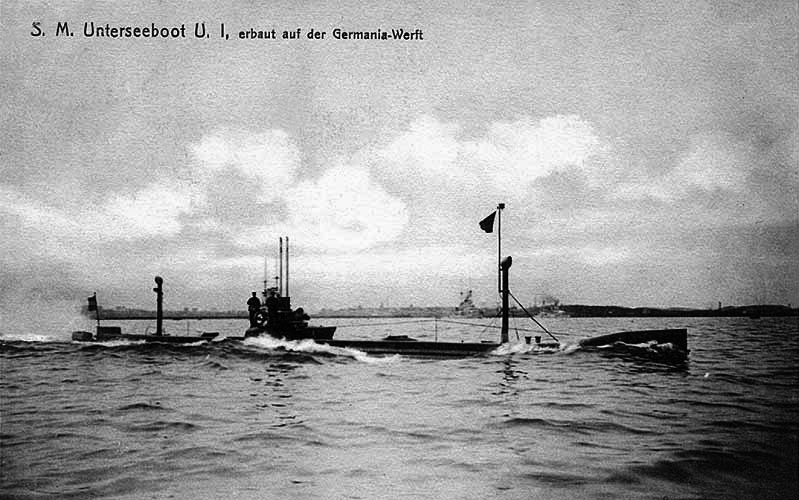
The path towards 1914 U-Boats started somewhat later than other nations, which is odd for a country which at some point relied so much of this new weapon to win both world wars (and gained a long-lasting reputation a credibility for this type). As shown in the long introduction towards German’s firs serviceable submarines (Untersebootes), this was not a straightforward path. The U-1 was in short, the first service-capable German submarine, and thus, took the first numeral in a very long list. By the time of the November 1918 armistice, Germany would have produced circa 630 of these, more than all world’s nations combined. A surprising return of events knowing that it’s only after HMS Dreadnought was launched in February 1906, that U1 was launched herself, in August. And Yet, France, Britain, the US, Russia and Italy all had already a few serviceable submarine classes and in some case, a long experimental past.
Pioneers: Wilhelm Bauer and Frederich Otto Vogel
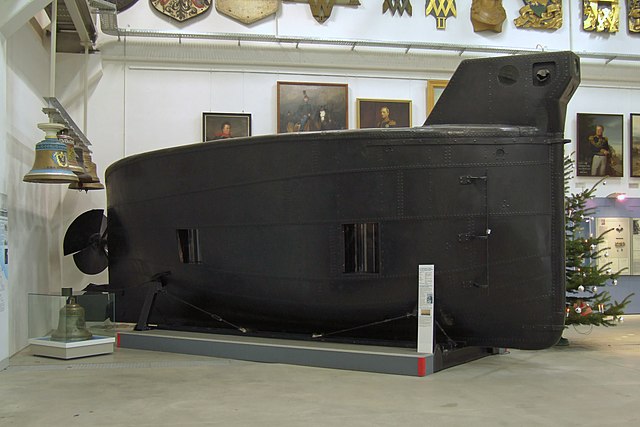
Brandtaucher, 1851, the first German submarine. She sank in Kiel at her first trial.
The fact is Germany was not completely stranger to submarines, pioneering this field with the the Brandtaucher as early as 1851. This is the earliest known German sub (soon called “unterseeboote”, literally undersea boat). Created by inventor and engineer Wilhelm Bauer, it was built by Schweffel & Howaldt in Kiel, as a proposal to the Prussian Navy, by then the richest, strongest kingdom of the German Empire, and only one with a significant Navy. There will be a dedicated post of the Brandtaucher at a later date, it’s an amazing story. It is now at the Bundeswehr Military History Museum in Dresden. Bauer was a non-commissioned artillery officer of the Bavarian army and fought at the war of Schleswig in April 1849, defending the Düppeler redoubt against the Danish navy. That’s where he understood the possibilities of an offensive submarine. He worked with Johann Schweffel et de Ferdinand Howaldt’s yard, to create an U-boote that could lay a mine under the keel of an enemy ship in shallow waters. However she sank during acceptance trials in Kiel, but the crew escaped. Her wreck was redicovered when dredging in 1887.
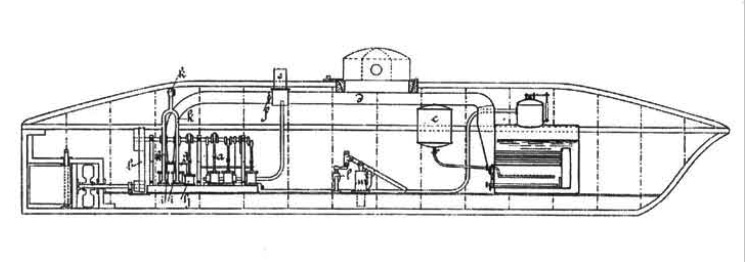
Friedrich Otto Vogel’s test submarine, 1869
Another early attempt was in 1868 by Friedrich Otto Vogel’s with a prototype which sank on trials. Vogel was born in 1844 in Dresden, a former professor, her created his first boat at F. Raschke workshop in Friedrichstadt. But the hull was riveted and weak and not waterproof. The second one was stronger and larger, but it could not complete it due to finances issues, turning to the Royal ministry of Saxony and of Prussia which both refused, his boat scrapped and himself left broke. It was never tested, and the following Year (1870), French novelist Jules Vernes released his famous “Twenty Thousand Leagues Under the Sea” showcasing his submarine Nautilus, powered with something close to nuclear power… Undersea propulsion remained a headache for decades. It was an area where the concept seemed in the hands of inventors and lunatics, never reaching credibility.
A decade of inspiration

The Resurgam, from Reverend Barrett (1879).
Thus decade and the next saw a flurry of new projects from many inventors across Europe and the US, but admiralties were still skeptical. In 1874 John Phillip Holland submitted his design to the Secretary of the Navy, was rebuffed and turned to the Fennians later (Irish nationalists) to fund his project. 1879 saw Anglican Reverend George W. Garrett tested the steam-powered Resurgam, later refined as the Nordenfelt series of the 1880s. Thus potentially Prussia knew Sweden could have a submarine operational. In 1885, French designer Claude Goubet created the first all-electric submarine, battery-operated. 1885 saw US inventor Josiah H.L. Tuck showcasing his “Peacemaker” powered by a chemical boiler, the first AIP. By 1887 this time official interest was quickstarted when in 1887 the U.S. Navy announced an open competition for a “submarine torpedo boat”. The Navy was quite small (see the “old navy”) and wanted to quickstart a radical modernization. All admiralties took note.
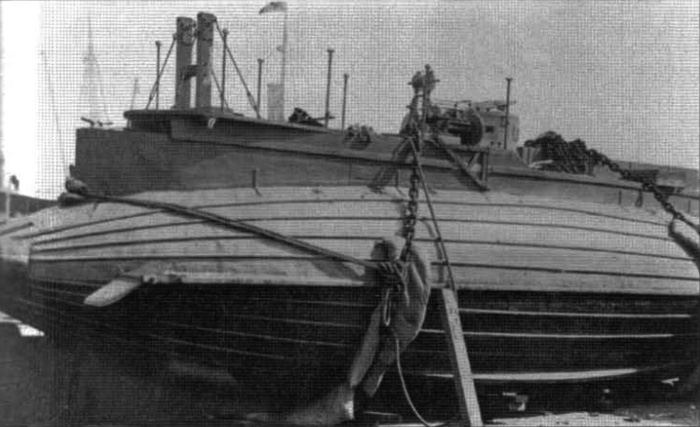
The so-called “Holwaldtboote”, now a known “semi-fake”. It was a private contraption that inspired little confidence…
Things accelerated as in 1888 Gustave Zede proposed his electric sub Gymnote, in 1889 Spaniard Isaac Peral’s submarine fired three Whitehead torpedoes in trials. But in 1891 in Germany, was born the “Howaldt Boote”. Mentioned by Delpeuch in 1902, it was a 180t, 30.25 m (99 ft) with a spindle shaped hull. The only picture taken is dated back 1891 in the literrature, but it was reported as a private boat belonging to Hermann Reiche in Hamburg and in reality less than 30 tons, made in wood and copper and it was built in the US and brought in Germany via a liner of the Amerika line in 1902… It seems it was only tried once but never inspired confidence in its solutions nor materials and fased into obscurity.
In 1893 at last it started to gain credibility: The U.S. Congress appropriated $200,000 for an “experimental submarine” competed by Holland, George C. Baker, and Simon Lake. Two years late, Holland won the competition and was ordered to build a 85-foot, 15-knot, steam-powered “Plunger”. Holland’s developments went on. Meanwhile in France was built in 1898 the 148-foot, 266-ton Gustav Zede, largest submarine so far. After the Hispano-American war, the competition between Holland and Lake intensified, the former testing his Holland VI and the second the Argonaut I and II. At the same time in Germany, the “Howaldt Boat N°333” was tested in Kiel, in 1898. Built a year before, it was the creation of a German torpedo Officer and built in a firm in Berlin, 15×2 meters in lenght and diameter, torpedo shaped with a box like keel. In October, she made a three hours run, submerging to two meters (7 feet). It was modern made in steel with horizontal and stern stabilizers and a rudder, 120 hp electric engine for 6 knots, forward torpedo tube. But the Kisertzky batteries were deficient after other trials it was refused by the directorate of torpedo systems for the Navy.
In 1900 USS Holland became the world’s first serviceable submarine. This time the conservative British admiralty under guidance of Jackie Fisher took notice and ordered five of their own to test the concept. The German Empire, now unified, started also to look at the new weapon, especially if the Royal Navy started to take it seriously.
Forelle and Krab
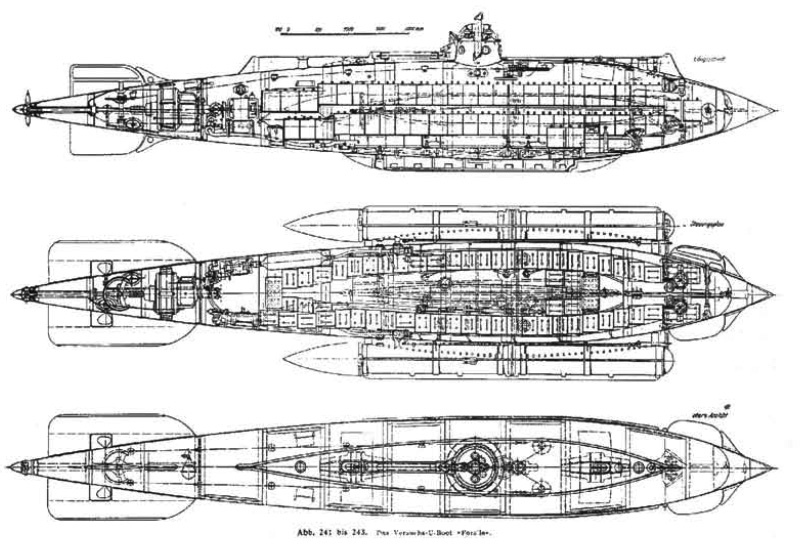
Forelle in 1904 was indeed the first German practical submarine.
Many subs were attributed retroactively to the Howaldtswerke. But the real first “blueprint” for U-1, on the path towards acceptability, was Forelle. In 1902, Spanish submarine designer Raimondo Lorenzo D’Equevilley-Montjustin came to see the German admiralty with his plans.
He was rebuffed however while attempting to put up his candidature, Admiral Alfred von Tirpitz jugding his proposed submarine was way too experimental. D’Equevilley thus, still sold directly his plans to Krupp Germania shipyard.
These plans would serve to design the 40-foot “Forelle” on speculation, using and electric plant with batteries inspired by the French Gymnote. Still lacking any interest from the admiralty, Krupp Germaniawreft proposed it to Russia, which attaché assisted to the recent tests in front of an impressed Kaiser Wilhelm II and his brother admiral. The Spanish engineer would later publish a book on the still young history of submarines and prophetized that future U-Boats would end naval battles for good and give supremacy to the navy that could muster them.
Note: I will not go into detail into her design as she would be the object of a dedicated post.
“The submarine is, at present, of no great value in war at sea. We have no money to waste on experimental vessels.”
Kaiserliches Marine Grand Admiral Alfred Von Tirpitz, 1904
 Krupp made good of this plans and created next the “Karp”, an improved design for Russia, more practical as fitted this time with a gasoline engine for surface-running, and improved onboard battery reloading system, the first of its kind. This gave the hew submarine an impressive range. Russia was impressed and ordered three more. This time, Krupp managed to convince many in the Navy and sell one for testing and evaluation to the Kaiserliches Marine: This was “U-1”.
Krupp made good of this plans and created next the “Karp”, an improved design for Russia, more practical as fitted this time with a gasoline engine for surface-running, and improved onboard battery reloading system, the first of its kind. This gave the hew submarine an impressive range. Russia was impressed and ordered three more. This time, Krupp managed to convince many in the Navy and sell one for testing and evaluation to the Kaiserliches Marine: This was “U-1”.
The Karp design was in part funded by the Russians, built on Spanish blueprints. This first single-hull boat had internal ballast and compensating tanks. But Forelle had serious limitations. Powered only by electricity like the French Gymnote, she lacking an underway recharging system, crippling her range. For the Navy she only could be a weapon usable from any harbour against a blockading fleet.
Karp was given two Whitehead torpedoes in tubes forward and was quite agile, between her diving planes and aft planes, but her single engine lacked range, so she has to be released close to her objective. The Russo-Japanese War ended just as she was completed and she missed her goal, but still, it skickstarted the development of Submarines both in Russian and Germany.
Her long trip from Kiel to Liepāja, commission in Kronstadt and transfer through the recent Trans-Siberian Railway to Vladivostok for the Pacific fleet was followed by a few years of testing until she was by 1908 used only for training, lost due to accident in 1910, salvaged but never repaired.
During all this time, the submarine concept gained traction and even respectanility. In 1901 President of France Emil Loubet made a submerged ride. In 1905 Theodore Roosevelt did the same on the A-1 Plunger, and in between in 1902, Kaiser Wilhelm II’s brother admiral took a ride on Forelle. Impressive as it may be, the Forelle was not a practical ship, and Karp had its limitations but showed the way forward.
Design of the class
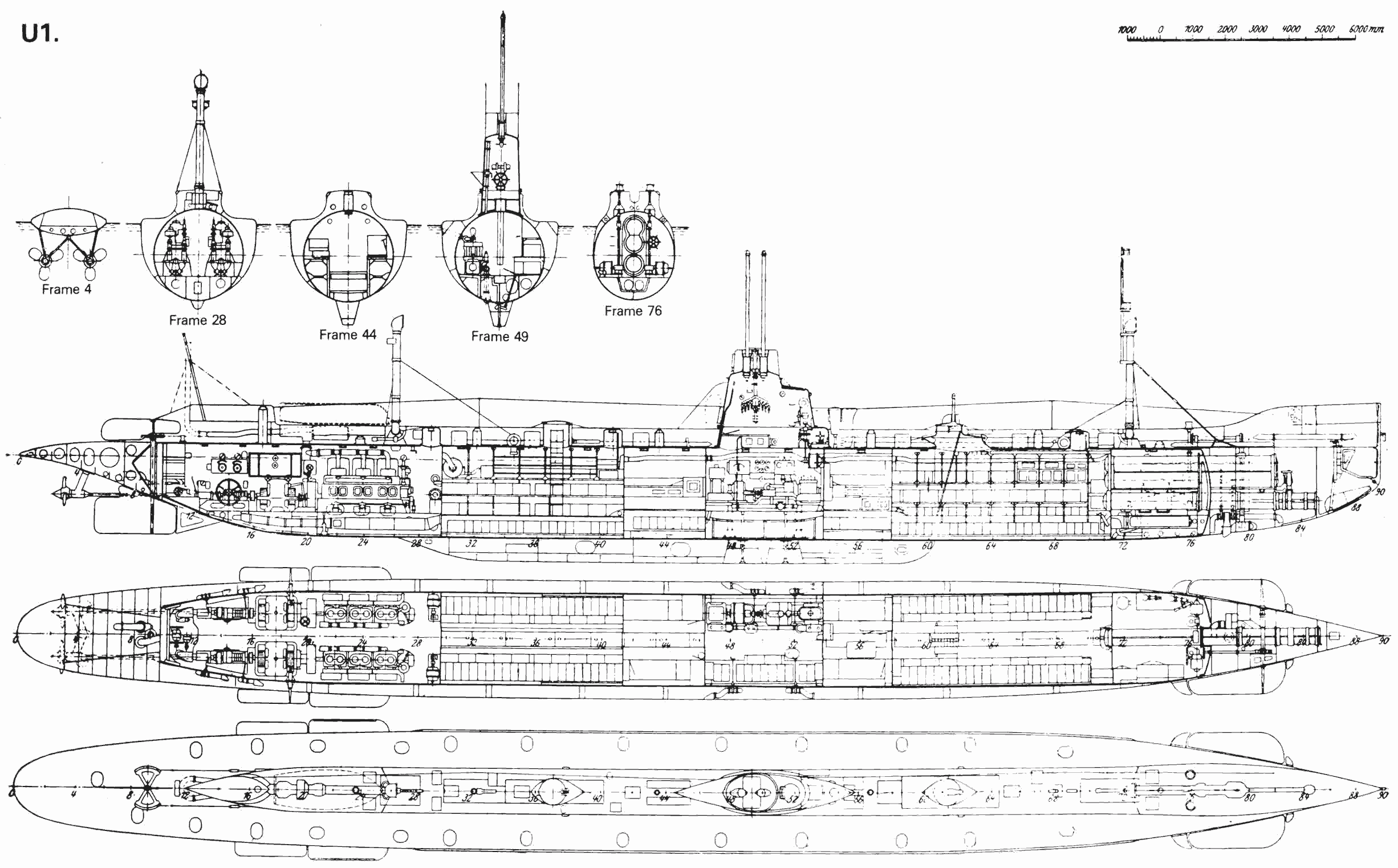
The Unterseeboote 1 was no longer a private venture. It was this time officially ordered by the admiralty in 1904 for tests, as a much improved version of the Karp for the basic specifications. Again, it was still in part the brainchild of D’Equevilley, but this time designed “by the navy and for the navy”, not in Howaldtwerke, but by Friedrich Krupp in the new admiralty yard of Germaniawerft, on official specification, and with a Kaiserlichemarine officer as permanent observer. It was of the double hull type, meaning instead of external ballast tanks, it had an internal pressure hull, following a trend in other navies. It largely was derived from the Karp, but with increased dimensions. Allso for the first time in included trim tanks instead of a moveable weight. It also had a redesigned forecastle for better seagoing ability.
Hull and general design
The external hull showcased the same shape as Karp, with a low flat deck, flat external hull deck, raised triangular prow. The deck was dotted with two hatches, one in front of the conning tower and another immediately aft of it. Two tall and prominent air intake masts were located fore and aft of the hull. Joint to the forward one was a mast holding navigation lights high enough to be seen in a rough sea state.
The pressure hull was 10 cm (3.9 in) larger compared to the Karp, diameter and strengthened to prevented oil leakage from external tanks. The design also included a complete rearrangement of the internal equipment. She also had a heavier ballast keel for quicker (or deeper) emergency rise.
She displaced 238 tonnes surfaced, 283 submerged (or 234/279 long tons) versus 207 surface/235 tonnes submerged for the Karp. Also 42.39 m in lenght, 3.75 m in width and 3.17m in draught (versus 39,6 x 2,7 x 2,5 m). The pressure hull was 32.50 m (106 ft 8 in) in lenght.
Particular attention was paid to speed and range, and thus, to the powerplant (see later).
The crew comprised two officers and two men, but later as training boat it was ported to 19 ratings and three officers.
The conning tower comprised a wave breaking base forward of the emerging pressure part, then a bulge containing the periscopes, and a rounded tail end. There was a platform aft of the bulge large enough for five men to stand, around the helmsman and its wheel. A barrier was strapped in canvas for better protection against water spray.
Powerplant
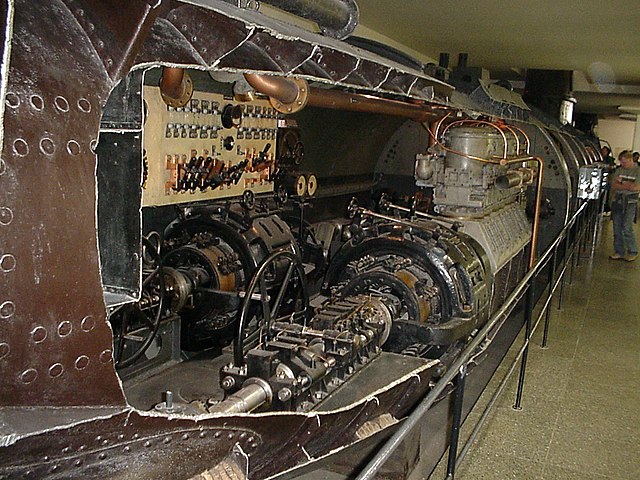
SM U-1. Photographed by Schoringer in April 2003 in the German Museum in Munich. Unfortunately, the submarine in the museum is modified in such a way that a reasonable overall picture is not possible. This is a view from the rear. The black lying “cylinders” are the electric motors. The light gray block in front is the starboard petroleum engine. The port engine was removed.
The Imperial German Navy wanted to avoid gasoline due to a real risk of fires and explosions seen on accidents in other submarines. So instead of the gasoline engines powered the Karp boats, U-1 was given the much safer Körting kerosene engines. These were still started using gasoline in normal use, but on U-1 satety went longer and dictated instead electrically-heated air starters.
The Körting had a limited transmission capability, and could not be reversed whereas they always run at full speed with a rate per minute that cannot be adjusted. Instead, engineers choose to fit her with adjustable-pitch propellers to at least better control the speed. However due to vibration issues, poor efficiency, and practicity, this solution was later were abandoned in later designs. Kerosene-electric propulsion became standard on all following U-Boats until diesels were adopted from the U-19 class onwards in 1912-1913. So the German submarine started to mature just at the eve of WW1…
U1 was powered by two 6-cylinder, 2-stroke Körting petrol engines for a total of 400 bhp (294 kW; 395 shp) and two Deutschen Elektromotorenwerke Garbe-Lahmeyer electric engines (From Aachen) combining a motor and a generator (“modyn”), plus batteries, capable of delivering 300 KW. (versus 2 shafts kerosene engines, 2 electric motors 400/200 hp, 10/8,5 knots surface/submerged and 2,315 km radius at min speed). Interestingly enough both the surface engines and electric ones gave the same rpm, 500 (nominal). The variable ptch propellers measured 1.30 m (4 ft 3 in), which was quite large for these small subs.
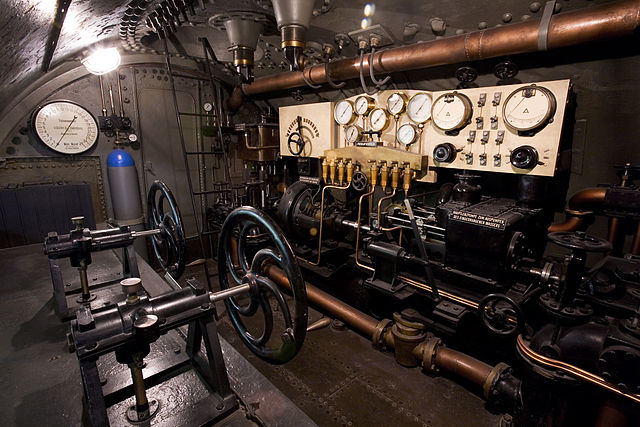
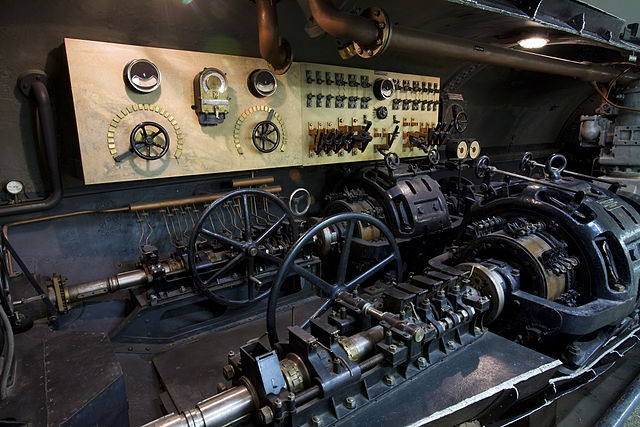
The engine room command post
Performance-wise, they were noted at 10.8 knots (20.0 km/h; 12.4 mph) surfaced in calm seas, and 8.7 knots (16.1 km/h; 10.0 mph) submerged, which was very honorable for the time.
As for range it could reach up to 1,500 nmi (2,800 km; 1,700 mi) at 10 knots (19 km/h; 12 mph) while surfaced and up to 50 nmi (93 km; 58 mi) at 5 knots (9.3 km/h; 5.8 mph), giving a relatively comfortable 25 nm of approach and escape run to the target. In practicality due to varying speed, the real range was c600 nmi due to higher regimes and the need to foray and return. It was sufficient to hope crossing the path of ships, not blockading but in international waters. The U-1 was also capable of diving to 30 m (98 ft) which was her safety limit as tested. Below, fears of water leaks meant 50 m was probably closer to crush depth as calculated.
Armament
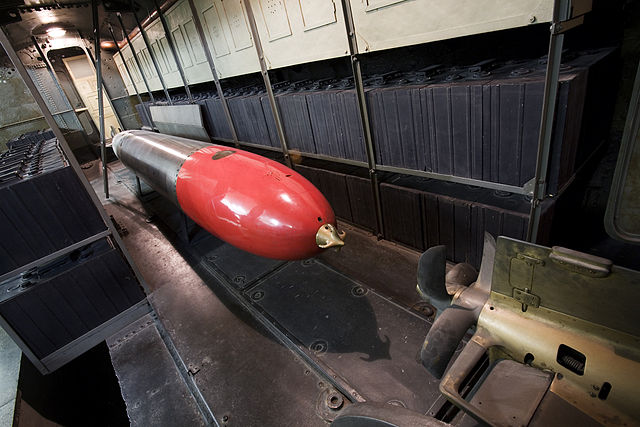
C/03 Torpedo and batteries behind.
U1 was fitted with a single 450 mm (17.7 inches) torpedo tube, which can be reloaded from above, with the hatch partly embedded in the triangular prow. Fortunately there were two spared torpedoes installed either side of the tube chamber. This means that once the torpedoes were fired, U1 was good to turn back and come back to port.
It was the 3 C/03 model (460 lbs. (662 kg), 203 in (5.150 m), 388 lbs. (176 kg) TNT 1,640/3,280 yds/31/26 kts, Brotherhood system), later replaced by the brand new 45 cm (17.7″) C/06 which entered service in 1907, 1,704 lbs. (773 kg) for 222 in (5.650 m) in lenght, carrying a warhead of 270 lbs. (122.6 kg) TNT to 1,640 yards (1,500 m) at 34.5 knots or 3,380 yards (3,000 m) at 26 knots due to her Brotherhood system. More on navweaps

⚙ specifications |
|
| Displacement | 238t/283t surf/subm |
| Dimensions | 42.39 x 3.75 x 3.17m (139 ft 1 in x 12 ft 4 in x 10 ft 5 in) |
| Propulsion | 2× Körting 6-cyl. kerosene 400 PS, 2× modyn 400 PS (294 kW; 395 shp) |
| Speed | 500 rpm, 10.8 knots/8.7 knots surf/subm |
| Range | 1,500 nmi (2,800 km; 1,700 mi)/10 kts/50 nmi (93 km; 58 mi) 5 knots |
| Armament | 1× 45 cm (17.7 in) TT, 3 C/03 torpedoes |
| Tets depht | 30 m (98 ft) |
| Crew | 2 officers, 10 men (later 3/19) |
Career of the U1

U1 was built in dock number 119, ordered on 3 December 1904, laid down on October 1905 and launched on 4 August 1906, commissioned on December 14, 1906, after several test trips. Construction cost was 1.905.000 Goldmark, way more than an average torpedo boat. This was equivalent to €11,620,000 in 2016. She became the first German military submarine to be commissioned by the Imperial Navy and thus was named S.M. (Seiner Majestät(schiffe)) U 1. First commander was Lieutenant Commander Erich von Boehm-Bezing.
As intended by the Kaiserliches Marine, U 1 was used exclusively for tests, and as training boat, shaping the first generation of German U-Boat officers and specialist ratings. She was homeported at Eckernförde, and moored at a specially-built submarine pier, the so-called “Isern-Düker-Steg” to test all submarines. The location was ell protected and ensured calm seas in almost all seaons, ideal for testing.
In September 1907 for the first time she made a cruise, over of 587 nautical miles, from Wilhelmshaven, around Denmark via the Skagerrak, and back to Kiel even undergoing difficult weather conditions. She went on in training until newer submarines were available but stll saw activity until 1919, a remarkable lenght for such an early experimental boat.
After suffering damage from a collision while on a training exercise in 1919, it was decided not to repair her, and she was either to destroyed or delivered to the entente. But the latter left her for scrap in Germany. So she was decommissioned on December 14, 1919. She was to be sold for BU but given her historical significance, Oskar von Miller, the founder of the German Museum in Munich persuaded the naval staff to sell him the boat.
For the long trip south, she had to be partially dismantled, transported in individual sections of the pressure hull only, by rail to Munich. She was then partially rebuilt in a limited space in 1921 and on display ever since, now one of the centerpiece of the exhibit in a partial cutaway form. A large portion of the starboard hull indeed was removed to allow visitors to see her interior. She can be visited inside as well with extra explanation boards and objects.
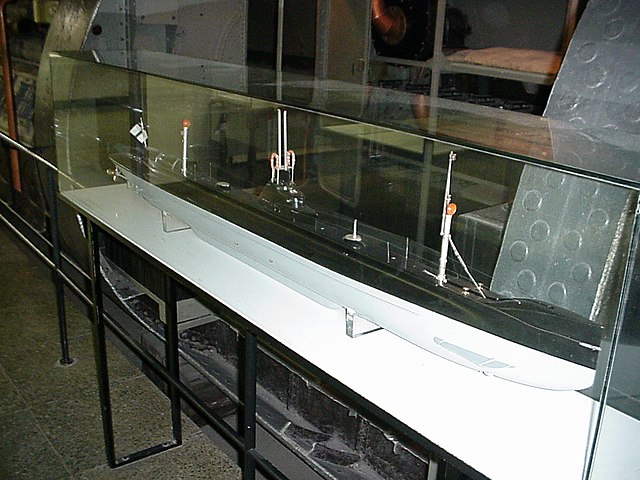
A model of U1 now inside the pressure hull in Munich’s Deutsche Museum
Read More/Src
Books
U-boats from 1904 to the present (pdf) src
Gröner, Erich; Jung, Dieter; Maass, Martin (1991). German Warships 1815–1945, U-boats and Mine Warfare Vessels. Vol. 2. Conway
Jameson, William (1965). The Most Formidable Thing: The Story of the Submarine from Its Earliest Days to the End of World War I.
Miller, David (2003). The Illustrated Directory of Submarines. MBI Pub. Co.
Rössler, Eberhard (1981). The U-boat : the evolution and technical history of German submarines. Cassell.
Rössler, Eberhard (1985). U-Bootbau bis Ende des 1. Weltkriegs, Konstruktionen für das Ausland und die Jahre 1935-1945.
Showell, Jak (2006). The U-Boat Century, German Submarine Warfare 1906-2006. Chatham Publishing.
Stern, Robert C. (2002). Battle Beneath the Waves: U-boats at War. Cassell Military Paperbacks.
Links
pbs.org nova history of subs
on uboat.net/
https://web.archive.org/web/20160527162157/https://www.bundesbank.de/Redaktion/DE/Downloads/Statistiken/Unternehmen_Und_Private_Haushalte/Preise/kaufkraftaequivalente_historischer_betraege_in_deutschen_waehrungen.pdf?__blob=publicationFile
on de.wikipedia.org/
spiegel.de/ the birth of U boats
joyofmuseums.com type-u-1-submarine/
https://museumships.us/germany/u-1
virtualdockyard.co.uk

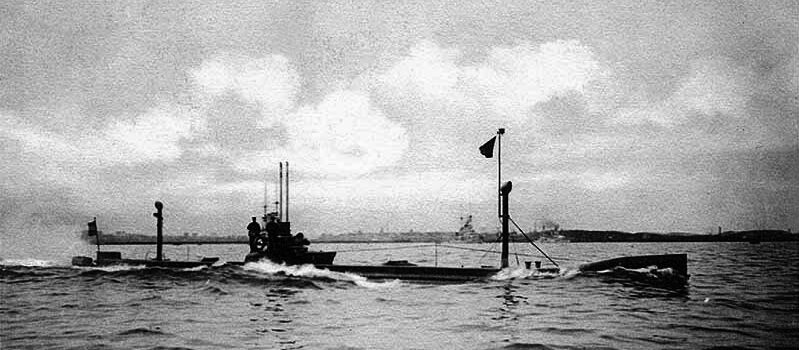
 Latest Facebook Entry -
Latest Facebook Entry -  X(Tweeter) Naval Encyclopedia's deck archive
X(Tweeter) Naval Encyclopedia's deck archive Instagram (@navalencyc)
Instagram (@navalencyc)





 French Navy
French Navy Royal Navy
Royal Navy Russian Navy
Russian Navy Armada Espanola
Armada Espanola Austrian Navy
Austrian Navy K.u.K. Kriegsmarine
K.u.K. Kriegsmarine Dansk Marine
Dansk Marine Nautiko Hellenon
Nautiko Hellenon Koninklije Marine 1870
Koninklije Marine 1870 Marinha do Brasil
Marinha do Brasil Osmanlı Donanması
Osmanlı Donanması Marina Do Peru
Marina Do Peru Marinha do Portugal
Marinha do Portugal Regia Marina 1870
Regia Marina 1870 Nihhon Kaigun 1870
Nihhon Kaigun 1870 Preußische Marine 1870
Preußische Marine 1870 Russkiy Flot 1870
Russkiy Flot 1870 Svenska marinen
Svenska marinen Søværnet
Søværnet Union Navy
Union Navy Confederate Navy
Confederate Navy Armada de Argentina
Armada de Argentina Imperial Chinese Navy
Imperial Chinese Navy Marinha do Portugal
Marinha do Portugal Mexico
Mexico Kaiserliche Marine
Kaiserliche Marine 1898 US Navy
1898 US Navy Sovietskiy Flot
Sovietskiy Flot Royal Canadian Navy
Royal Canadian Navy Royal Australian Navy
Royal Australian Navy RNZN Fleet
RNZN Fleet Chinese Navy 1937
Chinese Navy 1937 Kriegsmarine
Kriegsmarine Chilean Navy
Chilean Navy Danish Navy
Danish Navy Finnish Navy
Finnish Navy Hellenic Navy
Hellenic Navy Polish Navy
Polish Navy Romanian Navy
Romanian Navy Turkish Navy
Turkish Navy Royal Yugoslav Navy
Royal Yugoslav Navy Royal Thai Navy
Royal Thai Navy Minor Navies
Minor Navies Albania
Albania Austria
Austria Belgium
Belgium Columbia
Columbia Costa Rica
Costa Rica Cuba
Cuba Czechoslovakia
Czechoslovakia Dominican Republic
Dominican Republic Haiti
Haiti Hungary
Hungary Honduras
Honduras Estonia
Estonia Iceland
Iceland Eire
Eire Equador
Equador Iran
Iran Iraq
Iraq Latvia
Latvia Liberia
Liberia Lithuania
Lithuania Mandchukuo
Mandchukuo Morocco
Morocco Nicaragua
Nicaragua Persia
Persia San Salvador
San Salvador Sarawak
Sarawak Uruguay
Uruguay Venezuela
Venezuela Zanzibar
Zanzibar Warsaw Pact Navies
Warsaw Pact Navies Bulgaria
Bulgaria Hungary
Hungary

 Bundesmarine
Bundesmarine Dutch Navy
Dutch Navy Hellenic Navy
Hellenic Navy Marina Militare
Marina Militare Yugoslav Navy
Yugoslav Navy Chinese Navy
Chinese Navy Indian Navy
Indian Navy Indonesian Navy
Indonesian Navy JMSDF
JMSDF North Korean Navy
North Korean Navy Pakistani Navy
Pakistani Navy Philippines Navy
Philippines Navy ROKN
ROKN Rep. of Singapore Navy
Rep. of Singapore Navy Taiwanese Navy
Taiwanese Navy IDF Navy
IDF Navy Saudi Navy
Saudi Navy Royal New Zealand Navy
Royal New Zealand Navy Egyptian Navy
Egyptian Navy South African Navy
South African Navy






























 Ukrainian Navy
Ukrainian Navy dbodesign
dbodesign